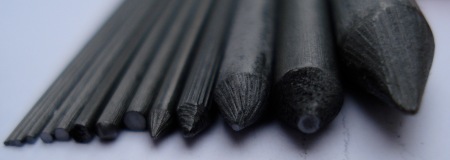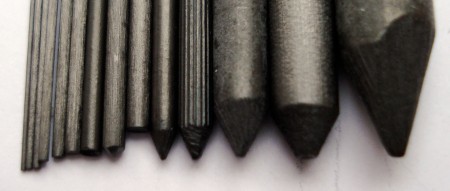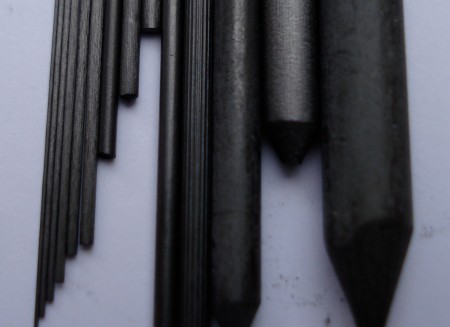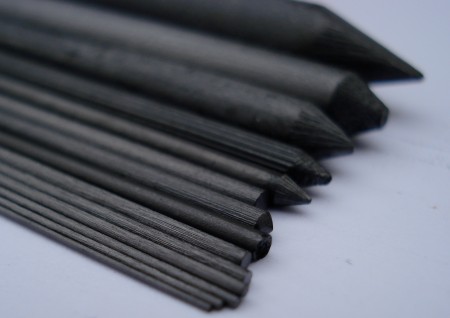
Photo (L-R): Leads in 0.2mm, 0.3mm, 0.4mm, 0.5mm, 0.7mm, 0.9mm, 1.18mm, 1.3mm, 1.4mm, 1.5mm, 2.0mm, 3.15mm, 3.8mm, and 5.6mm diameters
Mechanical pencil users have a lot of choice in lead diameters. Between thin leads used for drafting and wide leads used for sketching, most of us should be able to find something suitable.
0.2mm
That’s not a typo! Introduced by Pentel in 1973, the 0.2mm lead is used by the PG2 (or PG2-AD) Pentel pencil. It is extremely thin. Refilling a pencil with this lead is not unlike threading a needle. While I expected this diameter to be essentially unusable, I didn’t find any problems in practice. I’ll give some credit to Pentel here – it seems almost impossible to me that this lead wouldn’t continually break, but it didn’t.
0.3mm
For drafting, this is the thinnest lead made by a variety of manufacturers.

0.4mm
Also for drafting, this diameter is a Japanese specialty. Some ranges of drafting pencils are sold with this width in Japan, and without elsewhere.
0.5mm
The thinnest writing and general use diameter, it is also used for drafting.
0.7mm
A larger diameter also for writing and general use, as well as drafting.
0.9mm
Introduced in 1960, this was once the “standard” thin lead pencil diameter.
Today, it is used for drafting and a few general use pencils.
1.18mm
Prior to the 1960s, the standard lead diameter. Still used by Yard-O-Led, and a few others, including some companies that didn’t exist when this diameter was the norm!
1.3mm
Pentel and some other Japanese manufacturers have made light use of the 1.3mm diameter, and Staedtler recently introduced a pencil in the category.
1.4mm
The Faber-Castell Emotion was the only pencil using 1.4mm lead until Lamy changed their ABC from 3.15mm to 1.4mm. Still, an unusual lead.

1.5mm
The lead shown is a historical variant. (This example from Faber-Castell.) Fedra and others once made 1.5mm leadholders, but I’ve not been able to find one.
1.6mm
(Not Shown.) One of two in production diameters that I’m aware of that aren’t shown here. Faber-Castell Brazil makes 1.6mm pencils. (Brazil is also where the 1.4mm leads are made.)
2.0mm
The diameter of the lead in a standard woodcase pencil, 2.0mm is the beginning of ‘wide’ rather than ‘thin’ lead in many definitions. The standard for many drafting clutch leadholders made around the world, and carried in ‘big box’ stores, it is possibly the most available lead width apart from 0.5mm and 0.7mm.
2.5mm
(Not Shown.) Koh-I-Noor is the only modern manufacturer of this lead that I am aware of.
3.15mm
The outer realm of drafting lead diameters, this lead is today mainly used for sketching, though some drafting-syle clutch leadholders are still sold. The quite amazing Lamy Scribble introduced many of us to this format.
3.8mm
Used by Pilot, Caran d’Ache, and Koh-I-Noor, this diameter is also inside many art pencils (graphite, colour, and other). Strictly for drawing.
5.6mm
The largest standard lead that will be found in an art supply store, there are 5.45mm and 5.5mm subvariants. Very useful for sketching, pencils in this diameter continue to have a market.

There are a number of historic diameters not mentioned, but I think this list is correct at present. Let me know if I’ve missed something!
So, which lead diameter do you use?

I prefer B .9mm leads.
I’m a big fan of 0.7mm mechanical and 2.0mm clutch pencils for everyday writing, and I’ll occasionally use a 2.0mm clutch for sketching as well. My Staedtler 925 25-20 is my current workhorse. I like that it functions just like a mechanical pencil and fits in my Tru Point. Though I do most of my drawing with regular woodcase pencils or a 5.6mm “sketcher” depending on the format.
Mainly 0.7mm and 2.0mm. Comparing various widths of leads is a fun!
Good post. I have the 1.4mm Faber-Castell Emotion.
I like the Pental 0.5mm in B or even 2B in clicky mechanicals, and Lyra Orlow 2.0mm in HB for lead holders. My favorite woodcase pencil is the Lyra Orlow in B, or maybe the Palomino in HB.
Interesting diamaters, I only knew 0.3/4/5/7/9 and 2.0
I use 0.5 for regular use and have a 0.3 that I use every once in a while.
Is the 1.8mm the size Scripto uses?
Scripto- especially the 2B grade- leaves a mark very much like that of a wooden pencil.
The other size I favor is the 2mm, which fits clutch holders like Fixpencil and Koh-i-Noor.
~A
http://laviegraphite.blogspot.com/
The .9mm lead was widely available in the 1940s. It was known in the US by its English size equivalent, .036″.
Thanks. I must have been taking Pentel’s PR a bit too literally. They probably meant polymer vs. clay leads.
Another interesting point is that these diameters are essentially ‘labels’ – the leads aren’t necessarily exactly the stated diameter.
Abraham, your comment just came through, though the timestamp places it ‘out of order’. Sorry for that.
Scripto – their current pencils use what they call 1.1mm lead, which is another label for 1.18mm lead, shown in the photos. The brand is still around, though I haven’t seen their products at retail.
1.8mm lead (a typo, when you meant 1.18mm?) is an historic lead diameter.
Yes, that’s right- I meant 1.18mm (Scripto). Thank you!
This size, as well as the 2mm clutch size, rarely snaps while writing- and is especially good for those who bear down while writing.
I find these work really well on that waxy “Rite in the Rain” paper.
Pentel also produced the PS1042 with .2mm lead. I will be getting one of these shortly, and i have its counterpart in 0.5mm.
I have yet to .4mm lead pencils, but i have written with a few sent for inspection. its like using a .3mm without the breakage. I know as i get older, fine motor skills become distant. :)
Hi Germ. Hmm, the PS1042 is all metal. Thanks for the information.
These super fine widths are definitely not for casual use by those with a heavy hand, a category which includes myself. :)
I use 5.6 mm 4B (Koh-I – Noor) leads for writing. Mainly because I’ve fallen in love with a “Gessner” pencil, a replica of the “original pencil” from 1400something. It is not always practical even though I have to sharpen less than I expected. The “rotating technique” helps a lot.
I
also use Pentel’s twist erase 0.5 2B Ain. BTW I wonder why the 0.5 mm lead size has fallen out of grace with the luxury brands? More heavy writers? ? Us light writers seem to have less to choose from in this category these days.
However, most of the time I use wood cased pencils – and the Palomino is unbeatable, no matter the grade.
Regards Henrik
1.18 in my yard-o-led altough I don’t use it very much as I tend to use woodcase pencils much more. No. V from Graf von Faber-Castell :D
I am a big fan and happy user of 0.4mm pencils; my favourites are the Pilot S10, the Pilot H-1094 and the Pentel AccuGraph PG-1804 (of course the fact that they are quite exotic in Germany adds to the excitement). Does something have any information about the origin of that diameter? Has it been produced just to fill the gap between 0.3 and 0.5 or has there been a particular demand for it? Are there any other manufacturers besides Pentel, Pilot, Mitsubishi/uni and Ohto that had or have 0.4mm mechanical pencils in their range? And which mechanical pencil is considered the first with that diameter? – By the way: I use mainly Pentel Ain lead in B and 2B for these pencils and I am very happy with it.
The ISO 9177-n documents (which I think I learned about from Gunther) might have some relevant information. Unfortunately, the set of three standards is 126 Swiss Francs, and is comprised of just 11 pages (total) of documentation!
Completely speculating here – just as one has an arithmetic sequence that may be useful for clear line width differentiation in the 0.3mm, 0.5mm, 0.7mm, and 0.9mmm sequence, the existence of a 0.4mm lead allows for a similar but finer sequence with the 0.2mm, 0.3mm, 0.4mm, and 0.5mm leads.
I use the only diameter lead worth using (IMHO) and that is 0.3mm in HB grade. I mostly write with it but when I draw I also draw with it. When I worked for a company where I had to press hard enough to go through several layers of carbonless paper I used a 0.5mm HB pencil/lead because 0.3mm would tear the paper and the lead would break.
Recently I was introduced to the uni Kuru Toga 0.5mm rotating clutch pencil. The clutch turns the lead 9 degrees each time the pencil lead touches paper. Amazingly enough this produces a 0.3mm line! It has quickly become one of my favorite pencils. A very short while ago I ordered a 0.3mm Kuru Toga. By my calculations it should produce a 0.1mm line! If anyone is interested I’ll post results here when it arrives and I’ve had a chance to use it.
To OneLoneMan:
Yes please, I am interested in your results re “resulting line width” from a 0.3mm Kuru Toga. I consider the Kuru Toga a splendid idea — if it were not for the fact that you have to press quite hard in order to make the lead rotate; i.e. it calls for more pressure than what I have been taught
to use :-)
Have fun!
Claes in Lund, Sweden
I use 1.18mm lead almost exclusively because I press too hard when I write. I’m currently a college student so I have to write a lot. It certainly wouldn’t do to have my leads always breaking. I’ve met many people with the same problem. Perhaps the pencil companies should market the .9mm more and bring back the 1.1mm?
Slainna, thanks for your comment.
Great list! That was a fun read
I was just looking for the thinnest lead and matching mechanical pencil available after I recently came over a ~15+ year old 0.25-er with a few leads left
It’s a… rotring 100 I think it says, hard to read, the text’s a bit faded
I use 1.0/0.9, 0.5 and 0.3 (now 0.25) for drawing, preferably B or 2B if I come by any, the 0.3 was a great upgrade for details from the previous 0.5 which was all I used, but the 0.25 is surprisingly thin even compared to the 0.3
Is 0.2 the thinnest existing lead? There’s talk about thinner ones, from Pentel amongst others, but it all seems to be typos when I look into it
To oneloneman; I’m also interested in the Kuru Toga if you come to post your results, it sounds pretty cool!
Sleath, thank you for the comment.
That Rotring with a .25 diameter sounds very unusual.
I don’t know if 0.2 is the thinnest lead in existence – Pentel could have something even thinner in their labs. But it seems to be the thinnest diameter sold to the public by any major manufacturer.
Sleath, are you sure that it is really 0.25mm? Rotring has made the 600 models with a lead diameter of 0.35mm (and these work with 0.3mm leads).
… Gunther, upon very close inspection, I think you may be right
The number after “rotring” is just a dot that looks like the tip of a ‘1’ with the rest scratched off followed by two zeros, and the number after the comma in the diameter definition is just a slight curve at the top and a small line at the bottom, just like the number ‘2’… but now I realize a three fits in there aswell
I feel like such a fool now… it would have been so cool if it had been a 0.25
The people at the art stores made big eyes when they saw it
Oh well, slight disappointment, but it’s still a great 0.3mm
I asked instead for a PG2-AD mentioned here to be ordered, hope they can do it, they were supposed to call me about it but nothing yet
Sleath, besides the “600” (metal grip/metal barrel) there was also at least one “500” model (metal grip/plastic barrel) with 0.35mm lead and – if I remember correctly – a “400” (plastic grip/plastic barrel) with the same lead diameter. But that’s definitely no reason to feel like a fool :-)
Hello Pencil Talk,I am interested in any mechanical pencils with a lead size of 1.3 or larger.I know about the Pentel Fiesta model and have enjoyed using it for many years.Do you know of any others? Thank-You,Bill
Bill, there are the STAEDTLER graphite 771 and the graphite 760, both with 1.3mm (the latter is very similar to the Aristo 3fit with 1.3mm which only seems to be available in Japan). Besides there is the Pentel Mark Sheet but the two variants of that pencil (also with 1.3mm) are only available in Japan too.
What in your opinion is the best 0.3mm lead brand on the market now?
hey, couple of questions, im studying architecture, and we are know for using thick leaded pencils or mechanical pencils, i was wondering if 5.6 is the thickest there is? ive been looking around to buy one for a while but cant find anything, so if any of you guys know where can i get one, internet preferably :p, and any info about this would be greatly appreciated
There are various graphite sticks and crayons which are thicker than 5.6mm, but they wouldn’t be practical for precision drawing or creating thin lines. Bundoki.com and “Andrey’s pencils” on eBay both seem to have a good assortment of 5.6mm leadholders.
I lived in Japan for quite a while where it was much easier to try out a variety of pencils. I liked the idea of the 0.3mm but I found I was tearing the paper too much so I settled on 0.4mm. Great for note taking in small notebooks. Which brings up another point, Japan has a fantastic assortment of notebooks in many sizes with the most beautiful paper. I almost feel embarrassed to spoil the paper by writing on it.
I do wish the 0.4mm were more common outside of Japan. I find that for my small writing, 0.5mm is just a bit too wide (but wonderfully smooth and dark with a 4B Pentel lead), and 0.3mm edges on too brittle with anything dark.
I just recently picked up a 2mm leadholder, but with pencils like the Hi-Uni and the CDT 17 in regular use, it may be hard to find a great lead that will compete well. Anyone got any recommendations for a 2mm lead?
Really enjoyed reading all the comments. I have been using a Faber-Castell Emotion for about 6 months. I love it! I tend to write hard which meant I was always breaking leads. Not anymore! It’s is a funny little pencil, but if you have a heavy hand you may just want to give it a try.
ok, i think im gonna buy
http://www.amazon.com/Cretacolor-Drawing-Leads-Holder-Set/dp/B001CCXZMA/ref=sr_1_50?ie=UTF8&s=home-garden&qid=1240904445&sr=8-50
any thoughts on the cretacolor 5.6 mm lead holder? whats its material plastic or something else? thanks
Montblanc make the ‘Leonardo’ pencil with a 5.5mm lead, they also make their Classique pencils with either 0.5 or 0.7 inserts! – but I still prefer the robust reliability of the Yard-o-led, after all, it is one of the few that propells and retracts!
I have been using the drafting pencil since highschool, 1967. I had lots of lead to use up. The lead I’ve been using is 2H Lyra Orlow 6317. Is there a source for that lead or a subsitute?
Bundoki has Lyra Orlow 6317 in stock:
http://bundoki.com/?pid=1247083
Hi This has been tough to find…can you help….
super sized lead mechanical pencils 0.9mm
rectangular shaped lead if possible….I take 20 or 30 mechanical pencils
I need 2.0mm lead for a new mechanical pencil used by children. The pencil was designed to be disposable but this just seems wasteful to me. Any suggestions? V
If a test scantron requires a no. 2 pencil, would a mechanical pencil with 0.5mm lead work just the same?
Kyle:
Shouldn’t make any real difference. I don’t know if it’s wrong to link to another blog, but there’s a handy post about that very topic over on Dave’s Mechanical Pencils.
http://davesmechanicalpencils.blogspot.com/2009/09/number-2-pencils-hb-05-scantron-bubble.html
I have a cardboard tube with a cork stopper, about 2cm in diameter, full of 1.5mm leads. I found them in my father’s stuff, and I think they date back to when he worked for the phone company in the UK in the 1950’s. I’ve been trying to find a lead holder that would take them. I searched Bundoki (great site!) and Jetpens. I’m contacting Andreys Pencils on eBay now.
I would love to find something that would work. I have a Staedtler Mars 780 2mm holder, but the leads slide out. Maybe I can file down the grippers to make it grip the thinner lead…
Any other ideas?
Hi Matt,
I think Fedra and A. W. Faber both made 1.5mm leadholders. You might try asking Dennis at leadholder.com – I believe such an item is fairly rare today.
I just recently bought a Pentel PG2-AD 0.2 mm drafting pencil and for drawing precise construction lines, it can’t be beat.
You can find it for sale here: http://www.jetpens.com/index.php/product/view?products_id=1785
2.0 is good for drawing to!!!
Inspired by this blog entry, I’ve arranged a photo of some mechanical pencils of my own… pencils using ten different lead sizes: http://ow.ly/1sgiE0
Thanks Tttttim.
Here is the unobfuscated URL: http://www.flickr.com/photos/10239964@N04/5566345203/in/pool-80371140@N00/